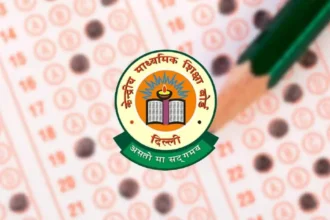Educational Desk : In today’s education system, where full emphasis is being laid on Academic Excellence, an unseen threat is harming the physical development of children. This threat is of Heavy School Bags.
Currently, many students go to school every day carrying bags weighing 4 to 6 kg, which is seriously affecting their Spine Health, Posture Development, and Muscle Strength.
Due to Textbook-Based Education in India, children need to bring separate books, notebooks, stationery and project materials for each subject daily. This makes the school bag’s weight exceed the child’s age-appropriate physical capacity. Unfortunately, this extra burden is not only physical, but it is also affecting the mental and social health of the child.
How does a heavy bag affect the body of children?
Between the ages of 6 and 14, a child’s body is in the process of development. Their spinal cord, shoulder, neck and back muscles are not fully strengthened. In such a situation, when the child lifts unbalanced or excessive weight every day, problems like spinal pressure, muscle strain and swelling in the joints start occurring.
Many times children hang the bag on one shoulder, due to which the weight bends to one side and the body posture deteriorates. This can cause Scoliosis i.e. one-sided tilt of the spine. Not only this, problems like Chronic Back Pain, Fatigue and Attention Deficit can also occur by lifting heavy bags for a long time.
Common Symptoms seen in children
Parents and teachers should pay special attention to some signs. If the child repeatedly complains of back, neck or shoulder pain, has started walking bent, feels extremely tired after school, or has started avoiding physical activity — then these can be early signs of Heavy Bag Syndrome. In many children, this pain can gradually turn into permanent postural issues, which may later require orthopedic treatment.
“The burden of studying on the spine of children cannot be ignored anymore. Schools should plan the timetable smartly and reduce the unnecessary clutter of books. We have started with small changes like ‘Light Bag Day’ in our school. Its positive impact is clearly visible on the energy and participation of children.” – Principal Surinder Kaur Malhi
Recommended School Bag Weight According to Grade
The maximum weight of the bag for children depends on their class and physical ability. The table given below has been prepared as per the guidelines of the Education Ministry and Health Experts.
|
Grade Level |
Maximum Recommended Weight (in kg) |
|---|---|
|
Grade 1 – 2 |
1.5 kg |
|
Grade 3 – 5 |
2.5 – 3 kg |
|
Grade 6 – 7 |
4 kg |
|
Grade 8 – 9 |
4.5 kg |
|
Grade 10 – 12 |
5 kg |
If the child lifts more than this weight every day, he may face backache, muscle pulls and coordination issues.
“Academic excellence is important, but it should not be at the cost of children’s health. Heavy bags are harming children’s physical health as well as their confidence. Our school is now working on e-homework and rotational subjects so that there is less weight every day. School and parents have to work together to free children from the burden.” – Principal Ajay Sharma
Long-Term Health Impact of Overloaded Bags
Heavy school bags have not only short-term but also long-term effects on the children’s bodies. Unbalanced weight can disturb their walking pattern, and this can lead to premature wear and tear in joints. Blood circulation in the body is hampered and sitting for long hours becomes difficult.
The major physical effects are listed in the table below:
|
Issue |
Health Impact on Children |
|---|---|
|
Pressure on Spine |
Risk of scoliosis and spinal misalignment |
|
Muscle Strain |
Fatigue, stiffness, and muscular pain |
|
Poor Body Balance |
Affects walking pattern and body posture |
|
Difficulty in Sitting Long |
Lack of focus and discomfort during class hours |
|
Forward Bending Posture |
Permanent impact on shoulders and back |
What can schools and parents do?
The responsibility of protecting children from this crisis is not only of doctors or parents, but also of school administration and policy makers. This problem can be prevented to a great extent by adopting some effective measures:
- Re-design the weekly time table so that fewer books have to be carried every day.
- Facility of classroom lockers or shelves should be provided in schools.
- Homework digitization should be promoted and e-notebooks should be accepted.
- Parents should be informed about the right design of bags, padding of straps and double-shoulder use.
Children should be encouraged to develop the habit of physical fitness and stretching exercise so that muscles remain strong.
The aim of education is not just to impart knowledge but to lead children towards a healthy and balanced life. If we put so much burden on the backs of children that it takes away their confidence, physical development and mental peace, then it will be the biggest failure of our education system.
Today there is a need for a collective effort – parents, schools and policy makers all have to ensure that every child goes to school without burden and remains physically and mentally healthy.
Get latest news on Education along with Board Exam, Competitive Exam and Exam Result at shiksha chronicle. Also get latest Job updates on Employment News.





